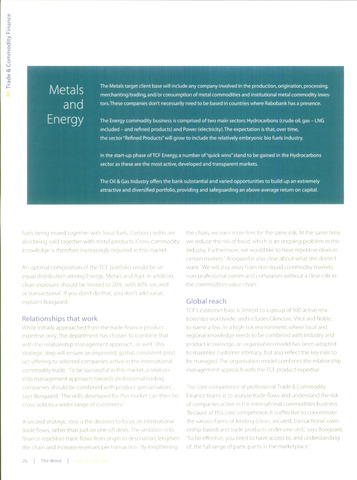Metals
and
Energy
Relationships that work
Global reach
The Metals target cliënt base will include any company involved in the production, origination, processing,
merchanting/trading,and/orconsumption of metal commodities and institutional metal commodity inves-
tors.These companies don't necessarily need to be based in countries where Rabobank has a presence.
The Energy commodity business is comprised of two main sectors: Hydrocarbons (crude oil, gas - LNG
included - and refined products) and Power (electricity).The expectation is that, over time,
the sector "Refined Products" will grow to include the relatively embryonic bio fuels industry.
In the start-up phase ofTCF Energy,a number of'quick wins"stand to be gained in the Hydrocarbons
sector, as these are the most active, developed and transparent markets.
The Oil Gas Industry offers the bank substantial and varied opportunities to build up an extremely
attractive and diversified portfolio, providing and safeguarding an above-average return on capital.
fuels being mixed together with fossil fuels. Carbon credits are
also being sold together with metal products. Cross-commodity
knowledge is therefore increasingly required in this market.
An optimal composition oftheTCF portfolio would be an
equal distribution among Energy, Metals and Agri. In addition,
clean exposure should be limited to 20%, with 80% secured
or transactional. 'If you don't do that, you don't add value,'
explains Boogaard.
While initially approached from the trade finance product
expertise only, the department has chosen to combine that
with the relationship management approach, as well. This
strategie step will ensure an improved, global, consistent prod
uct offering to selected companies active in the international
commodity trade. To be successful in this market, a relation
ship management approach towards professional trading
companies should be combined with product specialisation,'
says Boogaard. The skills developed for this market can then be
cross-sold to a wider range of customers.'
A second strategie step is the decision to focus on international
trade flows, rather than just on one-off deals. The ambition is to
finance repetitive trade flows from origin to destination, lengthen
the chain and increase revenues per transaction. 'By lengthening
the chain, we eam more fees for the same risk. At the same time,
we reduce the risk of fraud, which is an ongoing problem in this
industry. Furthermore, we would like to have repetitive deals in
certain markets.' Boogaard is also clear about what she doesn't
want. 'We will stay away from non-liquid commodity markets,
non-professional parties and companies without a clear role in
the commodities value chain.'
TCF's customer base is limited to a group of 500 active rela
tionships worldwide, and includes Glencore, Vitol and Noble,
to name a few. In a high-risk environment, where local and
regional knowledge needs to be combined with industry and
product knowledge, an organisation model has been adopted
to maximise customer intimacy, but also reflect the key risks to
be managed. The organisation model combines the relationship
management approach with the TCF product expertise.
The core competence of professional Trade Commodity
Finance teams is to analyse trade flows and understand the risk
of companies active in the international commodities business.
'Because of this core competence, it is effective to concentrate
the various forms of lending (clean, secured, transactional, own-
ership based) and trade products under one unit,' says Boogaard.
To be effective, you need to have access to, and understanding
of, the full range of participants in the marketplace.'
26 The Word

